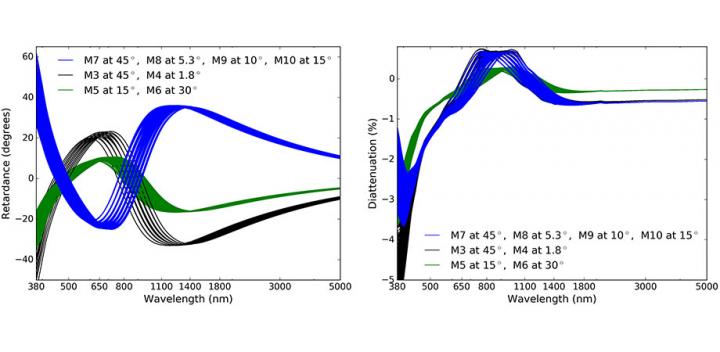The latest research, reported in the SPIE Journal of Astronomical Telescopes, Instruments, and Systems, will support the most powerful ground-based solar telescope ever built

Credit: The authors.
BELLINGHAM, Washington, USA and CARDIFF, UK – An article published in the SPIE publication Journal of Astronomical Telescopes, Instruments, and Systems (JATIS), “Polarization Modeling and Predictions for DKIST Part 5: Impacts of enhanced mirror and dichroic coatings on system polarization calibration,” marks a substantial advance in ensuring the accurate solar information measured and collected by the Daniel K. Inouye Solar Telescope (DKIST).
As with any astronomical instrument, calibration is required in order to remove effects that the instrument itself might have on the data. By concentrating on characterizing the telescope’s thin film metal coatings, anti-reflection coatings, and dichroic mirrors, the authors have developed unique computer models based on laboratory data for the polarization transmissivity of the entire telescope system.
Not only was the team able to predict the performance of a variety of devices in the optical system, they were also able to specify, design, and build compensating devices to correct for unwanted polarization. In addition, the team has the ability to fit multi-layer coating designs; this allows them to predict system-level polarization properties of mirrors, anti-reflection coatings, and dichroics at arbitrary incidence angles, high spectral resolving power, and on curved surfaces through optical modeling software packages. Altogether, the researchers have demonstrated confidence in the precision calibration of the telescope.
According to JATIS Associate Editor and SPIE Fellow James Breckinridge, the findings will help ensure that the DKIST will be one of science’s most powerful observational instruments: “In order to make sure you’re measuring what’s going on in the sun and not in the instruments, you have to calibrate the instrumentation, which is precisely what this research has successfully demonstrated. I believe that this telescope system has the most accurate and comprehensive polarization calibration of any astronomical telescope in the world. This will allow astronomers to measure solar features and activity to unprecedented accuracy, and should lead to many significant discoveries.”
###
The article authors are David M. Harrington, Stacey R. Sueoka, and Amanda J. White of the National Solar Observatory, Pukalani, Hawaii.
The open-access paper is part of a series investigating polarization performance expectations for the DKIST, a next-generation telescope, which, when completed later this year, will be the largest ground-based solar telescope in the world. Previous articles in this series were also published in JATIS.
Mark Clampin, SPIE Fellow and director of the Sciences and Exploration Directorate at NASA’s Goddard Space Flight Center, is the editor-in-chief of JATIS. The journal is published in print and digitally by SPIE in the SPIE Digital Library, which contains more than 500,000 publications from SPIE journals, proceedings, and books, with approximately 18,000 new research papers added each year.
About SPIE
SPIE is the international society for optics and photonics, an educational not-for-profit organization founded in 1955 to advance light-based science, engineering, and technology. The Society serves 257,000 constituents from 173 countries, offering conferences and their published proceedings, continuing education, books, journals, and the SPIE Digital Library. In 2018, SPIE provided more than $4 million in community support including scholarships and awards, outreach and advocacy programs, travel grants, public policy, and educational resources. http://www.
Contact:
Daneet Steffens
Public Relations Manager
[email protected]
+1 360 685 5478
@SPIEtweets
Media Contact
Daneet Steffens
[email protected]
Related Journal Article
http://dx.



